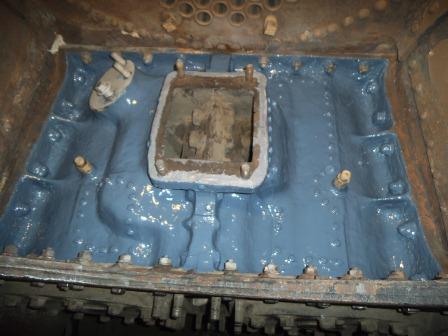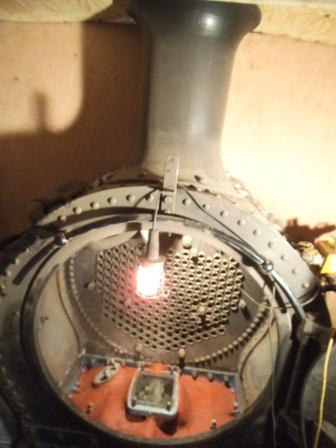As a part of the celebration of the London Underground’s 150th anniversary, the steam locomotive Metropolitan No. 1 is making trips on the city’s Metropolitan line during special events held throughout 2014. Met 1, as the train is known, was built in London in 1898, and to prepare for the festivities, the London Transport Museum of Covent Garden commissioned The Flour Mill Ltd. for the repair and overhaul of the locomotive. After a steam leak in the original cylinder block was detected, Bill Parker of The Flour Mill Ltd. knew he needed a modern-day solution to keep this piece of London’s heritage in operable condition. He contacted Mark James of Belzona, and together, he and James fixed and recoated the steam chest of the locomotive, a repair that was made possible by high-tech Belzona coatings.
A Piece of London’s Heritage
The Met 1 is the only working steam train left in the United Kingdom that was actually built in London. This makes the locomotive a fitting choice to help celebrate the 150th anniversary of the London Underground, the world’s first underground railway. And the engineers at The Flour Mill were the perfect choice to repair and refurbish the steam train. “In 1996, I set up The Flour Mill workshop in the Forest of Dean to preserve the industrial skills needed to repair and maintain steam railway locomotives,” explained Parker. He and his staff worked on Met 1 10 years ago, and they were happy to once again overhaul the historic train for its celebratory runs in the Underground.
The work began in 2012, and in 2013, the locomotive made several successful trips. However, late last year, a small steam leak was discovered. “The steam chest, which is part of the main cylinder block on the engine, had corroded and had several holes due to steam pressure and exposure to corrosive chemicals over many years. Without fixing these holes, the engine would lose pressure and fail to run,” said James.
According to Parker, replacing the steam chest would have required a massive amount of work, both in dismantling the engine and removing the cylinder block — to which the main frames and the boiler are attached — and having another cylinder block made. This alternative was not only time and labor intensive but cost prohibitive as well. Fortunately, Parker had previously worked with Belzona on a locomotive repair and knew that there was another solution.
 “The Flour Mill had previously carried out similar repairs on a locomotive belonging to the National Railway Museum of almost identical age — the 1899 London & South Western Railway T9 express locomotive — using Belzona coatings. The engine had been taken out of use as ‘beyond repair,’ but the use of Belzona coatings supported by steel patches screwed into the sounder parts of the cylinder block casting proved successful,” said Parker.
“The Flour Mill had previously carried out similar repairs on a locomotive belonging to the National Railway Museum of almost identical age — the 1899 London & South Western Railway T9 express locomotive — using Belzona coatings. The engine had been taken out of use as ‘beyond repair,’ but the use of Belzona coatings supported by steel patches screwed into the sounder parts of the cylinder block casting proved successful,” said Parker.
He approached the owners of Met 1: the Buckinghamshire Railway Society and the engineers of the London Underground for approval of the Belzona repair option. “Use of modern products such as Belzona coatings makes it possible to continue operating machines more than 100 years old, provided the engineers and managers are willing to go the extra mile to understand and approve ‘non-standard’ repairs,” said Parker. Both the Buckinghamshire Railway Society and the engineers of the London Underground agreed that the repair was more than acceptable, and Belzona and The Flour Mill were ready to get to work.
Keeping Warm
With the repairs and coating application scheduled for the month of February, a time of year that averages 4° C (39° F) in the Forest of Dean, a way had to be found to keep the work area heated for the application of the Belzona coating products. “The Flour Mill built a timber-framed and plywood-sheet-application hut to keep the area tight and warm. Conventional radiant and convection heaters were placed in the hut and underneath the engine block to warm the area to at least 18° C [64° F], the temperature required to apply the Belzona products we used,” said James. In addition to keeping the application area warm, the hut also helped prevent dew from forming on the metal surfaces of the steam chest. The train was left heated in the hut for seven days after the coating application to allow for full chemical and heat resistant cure times of the Belzona coatings.
The Past and the Present Converge

Once the application hut was built, the first step in the repair of Met 1’s steam chest was to place steel plates over the cast iron substrate. “The Flour Mill made hand-formed steel plates that were bolted to the steam chest to seal the existing holes in the steam chest,” said James. The area was then grit blasted to prepare the surface for the application of the coating system.
James performed the coating work himself with the help of Geoff Phelps, the head engineer at The Flour Mill, who mixed the products. The first layer of the system to be applied to the steam chest was
Belzona
1511 (Super HT-Metal), a two-component high-temperature repair composite that is designed for rebuilding metals damaged by corrosion. “The 1511 HT was applied using Belzona applicators and spatulas at a thickness of 5 mm [0.04 inches] all around the plate edges to bond and seal the plates as they were tightened into place by the bolt heads. The edges of the plates were then profiled smoothly with the same material to remove any sharp edges around the plates and to give a neat finish,” said James.
The second layer of the coating system consisted of one coat of Belzona’s 1391 (Ceramic HT), another two-component high-temperature coating system, which is designed to operate under continuous immersion up to 120° C (248° F). "The 1391 Ceramic HT was applied over the entire top of the steam chest at a thickness of 32–40 mils [813–1,016 microns] and was measured with a thickness gauge during application to achieve uniformity. This coating was applied with normal paint brushes cut down slightly to ease application as the material is quite viscous in consistency,” said James.
At this point, it was time to apply Belzona’s 4181
(AHR
Magma-Quartz) acid- and heat-resistant screed. The 4181 was applied at around 50 mm (2 inches) thick to seal and level the area and to provide extra protection from corrosive chemicals and steam vapor produced by the coal and combustion process. James applied the 4181 using a small trowel and, in certain areas, applying by hand, finding this method easier due to the uneven shape of the steam chest and bolt heads.
The final step in the coating process was the application of 50 mm (2 inches) of fire cement to the area. “The fire cement served as a leveling screed. It also helps the steam chest look as it did originally prior to the repairs,” said James. The protective 4181 screed is bright red in color and makes the repair work that’s been done obvious to the eye. The fire cement helps create an authentic look.
All Aboard
Thanks to the hard work of the Belzona and The Flour Mill team, Met 1 is ready for its scheduled trips through the London Underground this summer. Both Parker and James are happy to have been a part of such an important repair project that honors London’s steam locomotive heritage.
